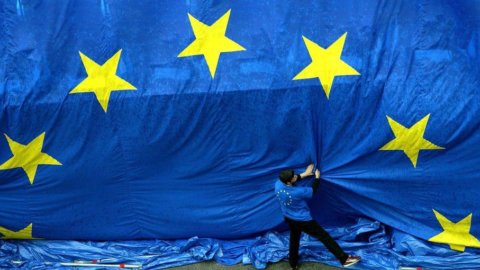“Sindona, Biography of the Seventies” (Einaudi, February 2016, 158 pp.) is a book in which Marco Magnani, an economist at the Bank of Italy, recounts some events that took place in Italian finance between 1960 and 1986: years that marked the parable of Michele Sindona, from the purchase of the first bank (the Privata Finanziaria of Milan) to his suicide in the prison of Voghera. For those who, like me, have somehow seen those facts up close, Magnani's pleasant pen represents an occasion for remembrance and reflection; I highly recommend reading it.
Much has already been written about Sindona, but this book represents a reasoned ordering of all the known and lesser-known "truths", most often presented by other authors with scandalous and superficially accusing tones. My question is: “How could all this happen?” There is some sense of orthodox religiosity in the Author's narrative because evil is ultimately vanquished by good. Evil is represented in Sindona: Guido Carli gave it an unequaled definition: "sinister but undoubted greatness". I was a customer of Banca Privata Finanziaria, of the only branch in via Verdi, in the heart of the City of Milan. I still remember an impeccable environment, with proud, quick employees, at the height of professionalism, who maintained a "gentlemanly friendly" relationship with customers; with "all" clients considering that I was probably the poorest at the time, being in my second year on the job, with an account balance close to zero and no recommendations.
Unfortunately, the man from Patti leveraged what Paolo Baffi called the "political-business-judicial complex"; a system based on corruption fueled by donations of money obtained from embezzlement and delinquency, from operations carried out in contempt of the laws often causing losses to the State and to unaware and greedy savers at the same time. In Sindona's final years, intimidating maneuvers by his cronies are part of the picture, strengthened by affiliation with deviated Masonic orders, mafia gangs, groups of fixers well introduced in the secret services and the Vatican, coup plotters. All under the (protective or creative?) umbrella of a Giulio Andreotti of whom, Magnani reveals, Enrico Berlinguer confessed that "in the [Communist] party they had not yet figured out whether he was an angel or a devil". Magnani's story is obviously full of demons, including that Monsignor Marcinkus who will certainly be paying for his earthly atrocities in the afterlife. But also that lawyer Guzzi who, undoubtedly out of official duty, "negotiated" Sindona's interests with the counterparts (the "good guys" in Magnani's film) totally undisturbed. This despite the fact that the police were aware "live" of the fraudulent nature of the object of those negotiations; the phones of the protagonists were in fact strictly monitored. A police that depended on Andreotti as head of government and therefore it was counterproductive to call to claim defense. Therefore, all this evil could have happened because Sindona created a real empire, a large banking and financial system, moreover global, as such capable of imposing very strong and effective instruments of corruption. And he exploited, according to Magnani, the (undoubted) political weaknesses and those of the supervisory systems in Europe and the United States that Magnani justifies a little too good-naturedly with the difficulties of adjusting to the rapidly changing scenario of those times. It remains to establish the boundary between weaknesses, incompetence and connivance.
But, in the final analysis, why was Sindona defeated? I do not agree with the author's conclusion. I believe that the "courage of the few who tried, as far as possible, to stem the decline of the public spirit of which the banker was the paradigmatic expression" was certainly needed. He doesn't make a list; in mine the "heroes" are not limited to Giorgio Ambrosoli who paid for his moral and professional inflexibility with his life. They include those characters of equal morality and righteousness who could have allowed Sindona to carry out his scams, but resisted with their backs straight: Ugo La Malfa, minister of the Treasury in a government dominated by Andreotti and his party, Paolo Baffi and Mario Sarcinelli champions of a Bank of Italy firm in defense of the country, Enrico Cuccia, the banker of undisputed competence who refused (under concrete threats to his person and his family) to support the imaginative bailout plans proposed to him through the lawyers, Guido Carli, governor of the Bank of Italy who immediately identified Sindona's true nature, hindering him in every way. I do not agree with Magnani's problematic opinion on Carli: the lack of support from the Governor was also decisive.
However, I believe that the fundamental cause of Sindona's downfall was the losses; or rather the casual speculation on exchange rates which produced progressive shortages in the coffers of the banks and companies of the group, first of all, Generale Immobiliare; “I've never seen anything like it: madmen buying billions of dollars against European currencies. All the losses came from there” (these are the words of Massimo Spada, the Vatican banker, in a famous interview granted to Alberto Statera in L'Espresso of 2 January 1975). If those speculations, often illegal and carried out with the use of capital of dubious origin, had been successful, it is very probable that we would still have Sindona's empire at our feet today, supported by fears of "contagion" that allow the survival of too-big-to-fail big banks. This is because corruption and extortion are still, unfortunately, the order of the day and we see those same fixers of the Shroud's history re-emerging alive and well in the same places of the past. Here I see yet another lesson to be drawn: large dimensions and large concentrations, also and above all in finance, do not push towards efficiency and go against democracy.
Small corollary: therefore, the government which, advised by Bank of Italy, is reforming by pushing the banks to grow ever more is pursuing a policy that is not only wrong (because it does not take performance into account), but also dangerous. I find it strange that the Bank of Italy, which has covered the story of Sindona as a "good" protagonist, no longer remembers the lesson that its Magnani masterfully reproposes today.




